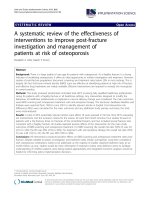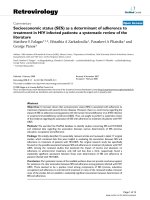Lecture How to read a Systematic Review: The FAST tool
Bạn đang xem bản rút gọn của tài liệu. Xem và tải ngay bản đầy đủ của tài liệu tại đây (2.05 MB, 49 trang )
How to read a Systematic Review:
The FAST tool
Find
Appraise
Synthesise
Transferability
Paul Glasziou
Centre for Evidence Based Medicine
University of Oxford
www.cebm.net
Are RCTs always needed for
treatment questions?
• Some immediate & dramatic
effects don’t need RCTs*
• Example:
• Child with nasal foreign body
Dislodged with Parent Kiss method
Case series of success 15/19
o Botma J Laryngol Otol 2000
* Glasziou, Chalmers, Rawlins, McCulloch BMJ 2007
What do you do?
• For an acutely ill patient, you do a search
• You find several studies: some show
significant results but many others don’t
Forest Plot/Blobbogram: of these 17 studies
A.
B.
C.
D.
Which is the smallest study?
Which is the largest study?
How many are statistically
significant?
Which studies are “large enough”?
Of these 17 studies: of streptokinase for MI
How large should the study be?
What sample size is needed?
For disease X the usual mortality rate is 0%
What sample size is needed to detect a
reduction in mortality?
• 100
• 1,000
• 100,000
• 1,000,000
Sample Size: Café Rule 1
The 50:50 Rule (proportions)
50 events are needed in the control group:
(For an 80% chance of finding a 50% reduction)
Control Rate Number
Events
20%
50
Control# Control#
(Rule 1) (Fisher exact)
250
215
10%
50
500
463
5%
50
1000
962
Glasziou P, Doll H. Was the study big enough? Two cafe rules. Evid Based Med. 2006;11(3):69-70.
What sample size is needed?
• There is usually a 12% mortality rate
You think your treatment will lower mortality
by 50%
• What sample size is needed?
What sample size is needed?
• There is usually a 12% mortality rate
You think your treatment will lower mortality by 50%
• What sample size is needed?
• 12% means
12/100 or 24/200 or 48/400
and 50 per 417
• Control + Treatment Groups = 834 in total
Systematic Review or meta-analysis?
• A Systematic Review is a review of a clearly
formulated question that uses systematic and
explicit methods to identify, select and critically
appraise relevant research, and to collect and
analyse data from the studies that are included
in the review.
• Statistical methods (metaanalysis) may or may
not be used to analyze and summarize the
results of the included studies.
Is the review any good?
FAST appraisal
• Question – What is the PICO?
• Finding
Did they find most studies?
• Appraisal
Did they select good ones?
• Synthesis
What to they all mean?
• Transferability of results
FIND
APPRAISE
SYNTHESISE
TRANSFERABLE
Why do I need to check the review?
Most reviews do not pass minimum criteria
A study of 158 reviews*
Only 2 met all 10 criteria
Median was only 1 of 10 criteria met
FAST tool = 4 criteria
* McAlister Annals of Intern Med 1999
FIND
APPRAISE
SYNTHESISE
TRANSFERABLE
What it the review question (PICO)?
•
•
•
•
Population
Intervention
Comparison
Outcome(s)
Do pedometers increase activity and
improve health?
• Find: what is your
search strategy?
Databases?
Terms?
Other methods?
Do yourself then
Get neighbour’s help
FIND
APPRAISE
SYNTHESISE
TRANSFERABLE
FIND: Did they find all Studies?
• Check for existing systematic review?
• Good initial search
Terms (text and MeSH)
At least 2 Databases: MEDLINE, EMBASE, CINAHL, CCTR, ...
• Plus a Secondary search
Check references of relevant papers & reviews and
Find terms (words or MeSH terms) you didn’t use
Search again! (snowballing)
FIND
APPRAISE
SYNTHESISE
TRANSFERABLE
Is finding all published studies enough?
• Negative studies less likely to be
published than ‘Positive’
• How does this happen?
• Followup of 737 studies at Johns Hopkins
(Dickersin, JAMA, 1992)
Positive SUBMITTED more than negative
(2.5 times)
FIND
APPRAISE
SYNTHESISE
TRANSFERABLE
Registered vs Published Studies
Ovarian Cancer chemotherapy: single v combined
Published
No. studies
Registered
16
13
1.16
1.05
95% CI
1.061.27
0.981.12
PValue
0.02
0.25
Survival ratio
Simes, J. Clin Oncol, 86, p1529
FIND
APPRAISE
SYNTHESISE
TRANSFERABLE
Registered vs Published Studies
Ovarian Cancer chemotherapy: single v combined
Published
No. studies
Registered
16
13
1.16
1.05
95% CI
1.061.27
0.981.12
PValue
0.02
0.25
Survival ratio
Simes, J. Clin Oncol, 86, p1529
FIND
APPRAISE
SYNTHESISE
TRANSFERABLE
Which are biased? Which OK?
1. All positive studies
2. All studies with more than 100 patients
3. All studies published in BMJ, Lancet,
JAMA or NEJM
4. All studies registered studies
FIND
APPRAISE
SYNTHESISE
TRANSFERABLE
Publication Bias: Solution
• All trials registered at inception,
o The National Clinical Trials Registry: Cancer Trials
o National Institutes of Health Inventory of Clinical
Trials and Studies
o International Registry of Perinatal Trials
• MetaRegistry of trial Registries
www.controlledtrials.com
FIND
APPRAISE
SYNTHESISE
APPRAISE & select studies
Did they select only the
good quality studies?
TRANSFERABLE
FIND
APPRAISE
SYNTHESISE
TRANSFERABLE
Miscalculating NNT
1. Does the death penalty for miscalculation
of an NNT discourage future
miscalculation?
2. Should we have the death penalty for
miscalculation of NNT?
FIND
APPRAISE
SYNTHESISE
TRANSFERABLE
Selective Criticism of Evidence
Biased appraisal increases polarization
Capital punishment: beliefs and contradictory studies
In Favour
2
1
0
Attitude
Against
Deterrent Efficacy
Proponents
Opponents
-1
-2
Lord et al, J Pers Soc Psy, 1979, p2098









